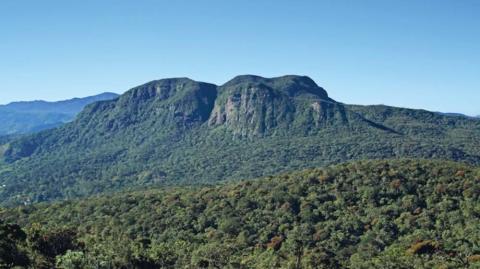Hakgala Strict Nature Reserve
Located adjacent the Hakgala botanical gardens, the SNR is an isolated cloud forest supporting a number of number of faunal species including some endemics. It was declared an SNR in 1938 and encompasses an area of 1142 hectares.
The name Hakgala is derived from the Sinahala word ‘hak’, meaning jaw, and ‘gala’, meaning rock, due to the mountain peaks in the Hakgala massif resembling an elephant’s jaw. Many species of endemic mammals such as purple-faced langur, toque macaque, mayor’s mouse, Ohiya rat, Kelaart’s long-clawed shrew, Sri Lankan long-tailed shrew, and Pearson’s long-clawed shrew are present in the SNR, some of which are strictly endemic to this region. Sri Lanka leopard, fishing cat, wild boar, Sri Lankan sambar deer, grizzled giant squirrel, red giant flying squirrel, and pungent pipistrelle can also be found in the reserve. Noteworthy bird species such as mountain hawk-eagle, Sri Lanka jungle fowl, Sri Lanka wood pigeon, jungle nightjar, Sri Lanka blue magpie, yellow-eared bulbul, brown-capped babbler, orange-billed babbler, dull-blue flycatcher, Sri Lanka bush warbler, Sri Lanka whistling thrush, spot-winged thrush, common blackbird, and Sri Lanka white-eye are preserved within the reserve and all five species of bird which are strictly endemic to this ecoregion are present in the reserve, showing that the Avifauna of the reserve exhibits a high degree of variety and endemicity.
Common birds such as scarlet minivet, small minivet, black bulbul, Sri Lanka scimitar babbler, grey-headed canary-flycatcher, pied bush chat, and Sri Lanka scaly thrush and a large number of migratory species including Indian pitta, Asian brown flycatcher, Kashmir flycatcher, Indian blue robin, pied thrush, black-throated munia, and large-billed leaf warbler care hosted within the SNR grounds. Adenomuskelaartii, Polypedatescruciger, Philautusmicrotympanum, Philautusschmarda, Ramanellapalmata, and Microhylazeylanica together with Fejervaryalimnocharis and bronzed frog are among the many endemic amphibians that inhabit the reserve.
Reprtiles such as Uropeltis melanogaster, Rhinophisblythii, Aspidurabrachyorrhos, A. trachyprocta, Hypnalenepa, geckos such as Calotesnigrilabris, Cophotisceylanica, rhino horn lizard, and skink species Sphenomorphusstriatopunctatum are also protected in the reserve.
Refence – DWC – Department of Wildlife Conservations
SLTPB – Sri Lanka Tourism Promotion Bureau

